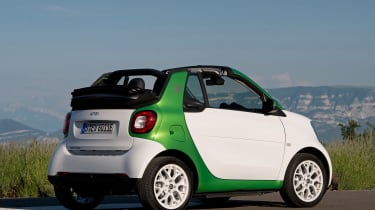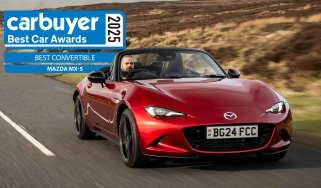Smart EQ ForTwo Cabrio convertible review
“If you want a fun, guilt-free way to enjoy driving around the city, the Smart EQ ForTwo Cabrio could be an ideal way to save money”
Pros
- Almost cost-free motoring
- Quirky and fun
- Ideal city car
Cons
- Expensive to buy
- Blustery above 50mph
- Small battery pack and short range
The Smart EQ ForTwo Cabrio is the convertible version of one of the smallest all-electric cars on sale. It follows the Smart EQ ForTwo and larger Smart EQ ForFour hatchbacks into UK showrooms and makes Smart the only brand that's updated its line-up to include an all-electric version of every model it sells.
While many electric models like the Tesla Model X are getting larger, faster and more luxurious, the EQ ForTwo Cabrio is designed to be masterful in the city and has few direct rivals. It shares its quirky character with the fun-but-flawed Renault Twizy, while other all-electric cars like the Renault Zoe, Volkswagen e-up! and BMW i3 are equally well suited to urban life.
This is the second version of the roofless and electric Smart, and while still just 2.69m long, it’s now wider and more spacious for a driver and passenger – although still strictly a two-seater as its name states. There are good reasons it hasn’t been lengthened; it’s still possible to park sideways in some parking bays and the turning circle is tight enough to allow quick maneuvers instead of three-point-turns.
The electric motor is completely new as well, with 81bhp available as soon as you press the accelerator, and a lithium-ion battery pack under the seats. Range has improved by around 10 miles to 99 miles, although Smart says having the air-conditioning running and driving in anything other than eco mode will see this drop to around 75 miles. This isn’t a particularly impressive figure, but in order to fit in the Smart, the 17.6kWh battery pack isn’t very big. It can be charged in just two and a half hours using a wallbox, with an even faster 22kWh charger also on the cards that can replenish the batteries from 10 to 80% in 40 minutes. For comparison, the Renault Zoe is available with a 41kWh battery and 180-mile range.
More reviews
In the city, an instant surge of power and total lack of gearchanges help the EQ ForTwo ED Cabrio scoot off the line faster than most traffic, while responsive steering makes for agile progress. It feels great from 0-40mph, but above 50mph things become rather more windswept inside. At least the extra 230kg weight of the battery pack actually makes the electric Cabrio feel more planted at speed than its petrol counterpart.
A bit like the Fiat 500C, the Smart’s fabric roof can be opened in two stages, with the first acting like a large sunroof, while the second retracts so the rear window folds and sits on the bootlid, although this makes rear visibility almost non-existent. Boot space hasn’t been affected by the switch from petrol to electricity, with a reasonable 260 litres of space, but access is tight through the small hatch.
While the Cabrio hasn’t been crash-tested by Euro NCAP, the hatchback version of the ForTwo received four out of five stars in 2014.
MPG, running costs & CO2
While the Smart EQ ForTwo Cabrio certainly isn’t cheap to buy, once you’ve taken the plunge, it should be very cheap to run. With no tailpipe emissions, the Smart is exempt from road tax and the London Congestion Charge, while business users enjoy the lowest 13% Benefit-in-Kind (BiK) band.
Importantly, the ForTwo ED Cabrio also qualifies for the £3,500 government plug-in car grant and the battery pack is included in the list price; you don’t have to lease on a monthly basis as is the case with some other EVs. Like any all-electric car, you need to pay for the electricity to charge it up, typically costing a few pounds for each full charge.
Engines, drive & performance
While figures of 0-62mph in 11.8 seconds and a top speed of 81mph might make the Smart EQ ForTwo Cabrio look like a runner-up in a city car wooden-spoon contest, the instant arrival of 81bhp and plenty of pulling power positively zips the Smart off the line. From 0-30mph it feels like a four-wheeled scooter, but without the annoying exhaust parp.
Acceleration is uninterrupted thanks to the single-speed gearbox, but once above town driving speed, progress tails off and the Smart’s odd proportions become apparent, with lots of wind noise generated by its upright shape.
The steering has been tuned to respond quickly and the ForTwo feels just as agile as the hard-top version, goading you to weave in and out of narrow streets. This is a car much more at home in town than on the motorway or country roads, but the 230kg weight of the batteries has surprisingly little impact on how it drives – and actually improves its feel through faster corners.
Interior & comfort
The interior is largely unchanged from the EQ ForTwo hatchback, with the same distinctive and well-built dashboard; an instrument binnacle with a gauge pod attached to the side and a central touchscreen that ‘floats’ in front of the fascia.
Despite some cheap-looking bits of trim, it’s generally a design that gives you the feeling of sitting in an upmarket car, even if a petrol Skoda Citigo feels just as classy for significantly less money.
Based on the Prime trim level, equipment is comprehensive, with heated front seats, cruise control, leather upholstery and 15-inch alloy wheels. The infotainment system comes with sat nav, and given the poor view out the back, it’s probably a good thing rear parking sensors are fitted, too. For around £600, you can upgrade to the Premium Plus Equipment Line, which looks like good value, adding a reversing camera, ambient lighting, LED headlights and rear lights, front foglights and automatic lights and wipers.
Practicality & boot space
Along with the Renault Twizy, the ForTwo ED Cabrio is one of the only two-seat electric cars, and unlike the Twizy, you at least get to sit next to your passenger. In fact, shoulder room has been improved for the second-generation ForTwo, thanks to wider and more spacious interior.
You sit fairly upright and getting in and out is made easier by doors that open nice and wide. The soft top still provides plenty of headroom when it’s closed and opening it results in the light and airy feeling you’d hope for. Actually, it can be a bit too airy at speeds of 50mph or more, with buffeting discouraging you from going too much faster.
Boot space is unaffected in the electric model, thanks to careful positioning of the battery pack. Measuring 260 litres, it’s 10 litres more than the Volkswagen e-up! offers, while the Renault Zoe is quite a bit larger, offering 338 litres. The space itself is somewhat compromised by the opening, which is too narrow for large bags or awkward items.
Reliability & safety
With fewer moving components and robust designs, electric cars are gaining a reputation for impressive reliability. The Smart certainly feels carefully engineered and the fact this small manufacturer is owned by Mercedes should add reassurance. The ForTwo also shares some parts with the Renault Twingo and the French firm knows a thing or two about city cars.
While the Cabrio hasn’t been crash-tested by Euro NCAP, the ForTwo hatchback it’s based on was in 2014, scoring four out of five stars overall. While this is discouraging, the ForTwo managed 82% for adult occupant protection and 80% for child occupant protection – impressive results for a car under three metres in length. It was marked down for lacking some of the latest safety technology like autonomous emergency braking.
Price, value for money & options
Costing around £23,000 before any deductions the Smart EQ ForTwo Cabrio certainly looks like an expensive city car. Indeed, if you simply want a fun, quirky electric city car to get noticed in, the Renault Twizy starts from £7,000, while the more sensible Renault Zoe costs from just over £22,000. This isn’t quite the full story, though, because while Renault leases the battery pack, in the EQ ForTwo Cabrio it comes with the car.
The Smart’s running costs should be negligible, bringing down its costs the longer you own it, and we’d expect resale values to be fairly good, too. A relatively small range could be a limiting factor, but we wouldn’t be surprised if most electric Smart owners have a few other cars with conventional engines, too, and use the EQ ForTwo ED Cabrio as a city runaround.
As standard, the EQ ForTwo Cabrio comes with 15-inch alloy wheels, heated front seats and a seven-inch display for the infotainment system. The latter boasts sat nav and a MirrorLink connection for Android smartphones. A heated steering wheel and improved door and interior insulation are part of a £300 Winter Package, while the £600 Premium Plus equipment line adds ambient lighting, automatic lights and wipers, LED exterior lights, front fog lights, a central armrest and rear-view camera.
See how this car scored on our sister site DrivingElectric






















